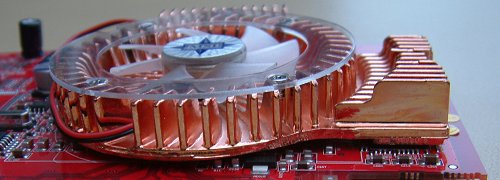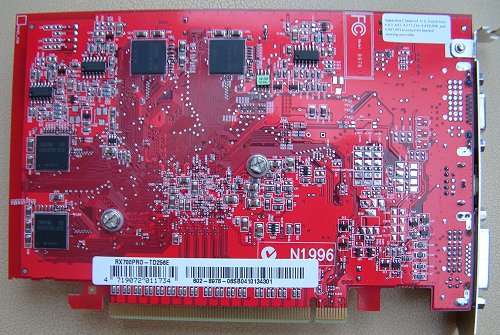Card appearance
MSI has been known to use custom heatsink and board designs for its range of ATI-based cards.
The MSI RX700PRO-TD256E, to give its full title, is an innocuous-looking design. We've come to expect certain NVIDIA high-performance cards to be laden with large heatsinks and outlandish coolers. I like the fact that ATI has always managed to mold performance with a minimal PCB and cooling package. As the card's name suggests, it's a PRO model, and one that sits between vanilla X700 and XT parts. I'll delineate the differences between X700 hierarchy a little later.
The first physical aspect of note is a native PCI-Express interface. PCI-Express (PCIe) is the flavour of the month right now and it's easy to see why. It affords greater graphical bandwidth and a more efficient design than the incumbent AGP protocol. I'll temper that by stating that there's little to choose between either interface for gaming right now, though.
MSI's X700 PRO runs at a standard core frequency of 425MHz and sports a two-quad (8) pixel pipeline setup. What's also pleasing is that the use of a PCIe interface has allowed ATI/MSI to do away with the need for auxillary power on a card that's endowed with decent fillrate. There's space for a 6-pin power adapter on the right-hand side but MSI's card does without.

The heatsink's a low-profile design that uses a large, slower-spinning fan for cooling the 110nm X700 core. As you can see, MSI decides that it's prudent to cool both GPU and RAM concurrently. There's nothing wrong with this approach if done correctly. MSI, however, simply has the cooler sitting on the core and making little contact with the RAM chips at all. Either have no RAM-specific cooling or ensure that the heatsink is in direct contact, via either thermal material or frag tape, with what it's supposed to be cooling.

Note the finned cooler for maximum heat dispersal. You can't tell from the above picture that the heatsink is just sitting on the RAM chips. There's very little heat transfer taking place. To MSI's credit, the fan is pretty quiet in use. It would only be noticeable in ultra-quiet systems.

There's a silkscreened portion of PCB to the left of the cooler. It's most likely reserved for ATI's venerable Rage Theater VIVO ASIC. Without it, the S-Video connector is used for video-out only. DVI and VGA ports allows the user to use two displays simultaneously. Dual-DVI would be nice.

A look at the back shows another 4 RAM chips, making 8 in total. This particular MSI X700 carries a healthy 256MB of on-board GDDR3 memory. The cooler comes away with the removal of the two screws shown in the above picture.

8 256MBit chips account for total video memory. Samsung is gainfully employed once again. This time, it's 2ns-rated (1GHz) K4J5532QF-GC20 DRAMs. The card's is clocked in at around 860MHz. Overclocking should be fun, fun, fun. All in all, a compact design that incorporates a potent GPU.









